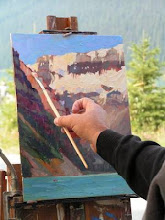Which is scarier, holding a tarantula in your hand,
or spending $5000 on a piece of artwork?
Both seem very formidable, but, with education and confidence, both can be accomplished, even enjoyed.
My partner, Anne Schreivogl, although normally very peaceful and kind, will not hesitate to smash any arachnid who dares to enter our home. "All bets are off when they've crossed that line," she says resolutely. Recently however, after a Ranger Talk at the Saguaro National Park near Tucson, she did not hesitate to let "Charlotte", a seasoned 16-year old tarantula, take her furry spider legs and crawl up and onto Anne to say hello. After the Ranger lecture she had the confidence to try it and from the photo, you can see she enjoyed the exchanged greetings. It turns out these cuddly "teddy bears" of the spider world don't like to bite unless very provoked, and the bite is minimal for humans.
So now, let's look at the scary business of spending signifcant money on art. Here are two important aspects to consider to lower your risk:
One: Why is the art priced the way it is priced?
With any risk, you want to understand what is at stake. As you begin to pay top dollar for art, its important to understand why are you are paying what you are paying.
Is this artist established and committed to their work? Have they been an artist for a long time? Are there magazine articles and printed material to support their efforts? Are similar pieces of that size by that artist close in price? Consistency in their commitment with gradual increases in prices over the years is key.
Two: Is it worth it for you to buy it?
Buying art, beyond the above considerations, ultimately comes down to how it moves you. If you aren't sure, then wait. However, if a painting or sculpture grabs you, and you walk away, and cannot stop thinking about it for days, weeks, or even months later, that piece is very likely to keep your interest for many years to come. Art is about emotion. Period.
If you are talking yourself into buying it, or feel you "should" own a piece because of the artist's name, you probably will not even notice that painting on the wall years later. Most decisions we make on purchasing things are rational and logical. "Is this toaster going to work well and last?" Art is one of the few purchases where we can buy based on how it makes us
feel. It is scary, but with the above guidelines, it can also be liberating and gratifying, and allow you to enter into a whole new world of joy and beauty.
So the next time you are looking at original art, whether in a gallery or at an artist's studio, keep these considerations in mind when you see a piece you are enamored with. In the end, you will avoid being bitten by the art world, and instead leave giddy and content.









































